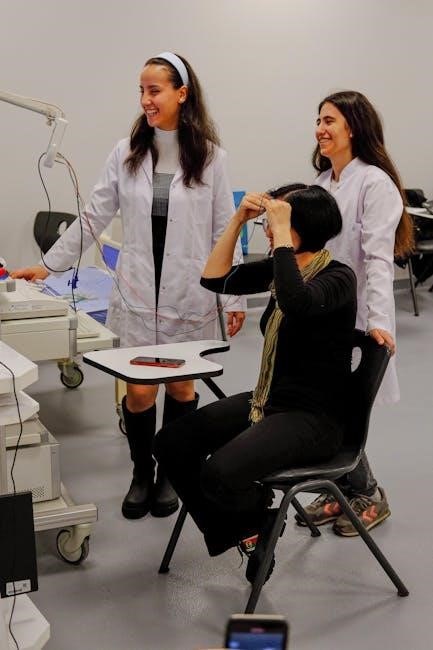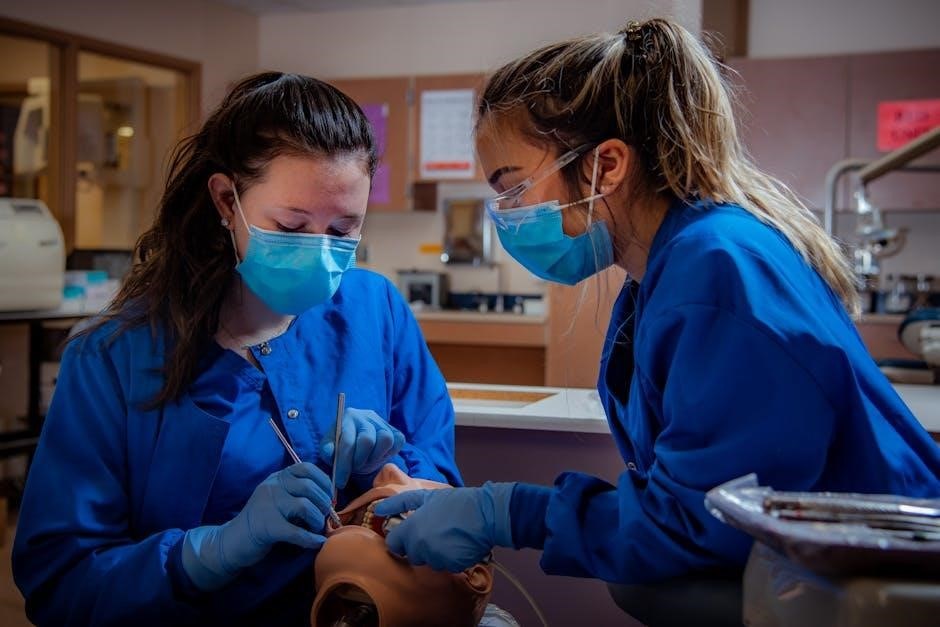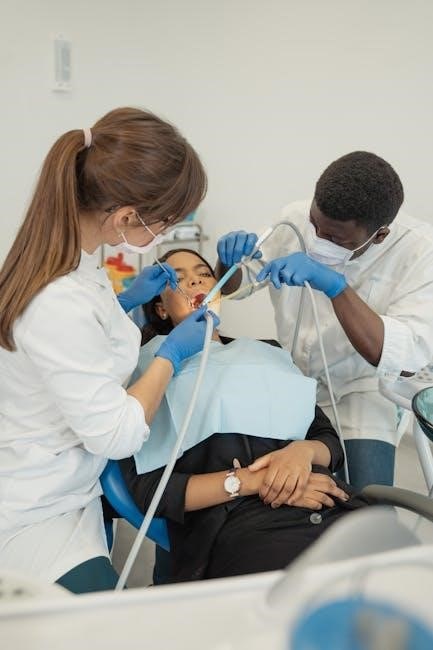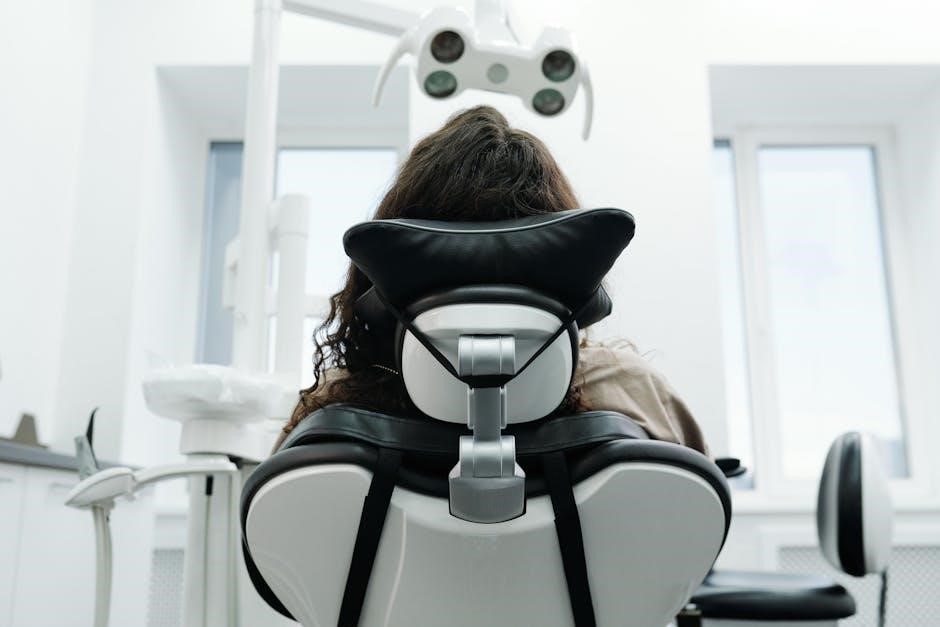A Medical Assistant is a healthcare professional trained to perform both clinical and administrative tasks, supporting physicians and other healthcare providers. The role requires a blend of technical skills, interpersonal communication, and organizational abilities. Training manuals, such as the Medical Assistant Training Manual PDF, provide a comprehensive guide for students and practitioners, covering essential procedures, ethical practices, and the use of modern healthcare technologies like EHRs and telehealth platforms. These resources are vital for mastering the profession and preparing for certification, ensuring Medical Assistants are well-equipped to contribute effectively in diverse healthcare settings.
Overview of the Medical Assistant Role
Medical Assistants are versatile healthcare professionals trained to perform both clinical and administrative tasks, ensuring the smooth operation of medical facilities. Their responsibilities include recording patient histories, measuring vital signs, preparing exam rooms, and assisting with procedures. Administrative duties involve managing electronic health records (EHRs), scheduling appointments, and handling patient communication. The role requires strong communication skills to interact effectively with patients, physicians, and other staff. Training manuals, such as the Medical Assistant Training Manual PDF, emphasize the importance of mastering both clinical and administrative competencies. These resources also highlight the integration of technology, like telehealth platforms, into modern practice. By combining technical expertise with interpersonal skills, Medical Assistants play a crucial role in delivering high-quality patient care and supporting healthcare teams.
Importance of Medical Assistants in Healthcare
Medical Assistants play a vital role in healthcare by ensuring efficient delivery of patient care and administrative support. They serve as a bridge between clinical and administrative functions, enabling healthcare providers to focus on complex tasks. Their versatility in handling both patient care and office management makes them indispensable in medical facilities. Training manuals, such as the Medical Assistant Training Manual PDF, emphasize their importance in maintaining high standards of care and operational efficiency. By performing essential tasks like vital sign measurement, medication administration, and EHR management, Medical Assistants contribute significantly to patient outcomes. Their role is crucial in preventive care, chronic disease management, and patient education, making them a cornerstone of modern healthcare teams.

Medical Assistant Training Programs
Medical Assistant Training Programs equip students with essential clinical and administrative skills through structured curricula and hands-on practice, preparing them for certification and real-world healthcare challenges.
Accredited Medical Assisting Programs
Accredited Medical Assisting Programs are essential for ensuring high-quality education and training. These programs are approved by accrediting bodies like CAAHEP (Commission on Accreditation of Allied Health Education Programs) and adhere to strict standards. They provide a comprehensive curriculum that combines both clinical and administrative skills, preparing students for real-world challenges. Many programs include a Medical Assistant Training Manual PDF, which serves as a detailed guide for students, covering essential procedures, ethical practices, and the use of modern healthcare technologies. Accredited programs also emphasize hands-on training through internships or practicum experiences, allowing students to apply their knowledge in clinical settings. Graduates from these programs are often eligible to take the Certified Clinical Medical Assistant (CCMA) exam, enhancing their career prospects in the healthcare industry.
Course Description and Curriculum
The curriculum for Medical Assistant training is designed to equip students with both clinical and administrative skills. It includes courses on patient communication, vital signs measurement, and electronic health records (EHR) management. The program also covers laboratory procedures, pharmacology basics, and medical ethics. A key resource is the Medical Assistant Training Manual PDF, which provides a step-by-step guide to mastering these skills. Practical training is emphasized, with hands-on experience in clinical settings. The curriculum ensures students are prepared for certification exams like the CCMA and ready to work in healthcare facilities. This comprehensive approach balances theoretical knowledge with real-world application, ensuring graduates are well-rounded professionals.
CAAHEP Accreditation and Its Significance
CAAHEP, the Commission on Accreditation of Allied Health Education Programs, ensures that medical assisting programs meet rigorous educational standards. Accreditation by CAAHEP is crucial as it validates the quality of training, preparing students for certification exams like the Certified Medical Assistant (CMA) exam. The Medical Assistant Training Manual PDF often aligns with CAAHEP standards, providing a structured learning resource for students. CAAHEP’s accreditation process involves evaluating curriculum, faculty qualifications, and program outcomes, ensuring graduates are competent professionals. This accreditation is recognized by employers, highlighting the importance of choosing an accredited program for a successful career in medical assisting.

Skills Development in Medical Assisting
A Medical Assistant Training Manual PDF focuses on developing clinical and administrative skills, ensuring structured learning for essential competencies. It emphasizes effective doctor-patient-MA communication and task proficiency.
Clinical Skills for Medical Assistants
Clinical Skills for Medical Assistant
Clinical skills are essential for medical assistants, enabling them to perform patient care tasks effectively. These skills include taking vital signs, preparing patients for exams, and assisting with procedures. A Medical Assistant Training Manual PDF provides detailed guidance on mastering these skills, such as using a manual sphygmomanometer or conducting blood collection simulations. Proper training ensures proficiency in handling medical equipment and adhering to safety protocols. The manual also emphasizes infection control and ethical practices, crucial for maintaining patient trust and safety; By following structured lessons and hands-on exercises, assistants can confidently execute clinical duties, contributing to efficient healthcare delivery and positive patient outcomes. These skills are fundamental for excelling in the role and supporting healthcare teams effectively.
Administrative Skills for Medical Assistants
Administrative skills are crucial for medical assistants, ensuring smooth operation of healthcare facilities. These skills include managing electronic health records (EHRs), scheduling appointments, and handling patient communications. A Medical Assistant Training Manual PDF provides detailed instructions on mastering these tasks, such as data entry, insurance verification, and maintaining patient confidentiality. The manual emphasizes effective communication and organizational techniques to streamline workflows. Proficiency in administrative duties allows assistants to support healthcare providers efficiently, ensuring accurate record-keeping and timely patient care. These skills are vital for maintaining a well-organized and patient-centered healthcare environment, making medical assistants indispensable in both clinical and office settings. Proper training ensures they can manage administrative responsibilities with confidence and precision, contributing to overall healthcare efficiency and patient satisfaction.

Clinical Procedures and Responsibilities
Medical assistants perform essential clinical tasks, including patient assessment, measuring vital signs, and assisting with minor procedures. A Medical Assistant Training Manual PDF provides detailed guidelines for these duties, ensuring accurate and safe practices in healthcare settings. These responsibilities are fundamental to delivering quality patient care and supporting healthcare providers effectively. The manual emphasizes proper techniques and adherence to protocols, equipping assistants with the skills needed to handle clinical procedures confidently and efficiently. This training is crucial for maintaining high standards of care and ensuring patient well-being. By following the manual, assistants can master these critical clinical responsibilities, making them invaluable in healthcare teams. The manual also covers pharmacology basics, wound care, and laboratory procedures, further enhancing clinical competence. Overall, the training manual serves as a comprehensive resource for excelling in clinical roles within healthcare facilities. It ensures that medical assistants are well-prepared to handle diverse clinical tasks, contributing to efficient and effective patient care. The manual’s structured approach helps assistants understand their roles and responsibilities clearly, enabling them to perform their duties with precision and professionalism. This, in turn, supports the overall goal of providing excellent healthcare services. The Medical Assistant Training Manual PDF is an indispensable tool for both training and reference, ensuring that clinical procedures are executed with accuracy and care. It is a vital resource for anyone pursuing a career as a medical assistant, offering insights and practical guidance that are essential for success in this field. By leveraging the information provided in the manual, medical assistants can enhance their clinical skills and deliver high-quality care, making a positive impact on patient outcomes. The manual’s focus on both theoretical knowledge and practical application ensures that assistants are well-rounded and capable of handling various clinical scenarios. This comprehensive approach to training is key to producing competent and confident medical assistants who are ready to meet the demands of the healthcare industry. The Medical Assistant Training Manual PDF is, therefore, a cornerstone of effective training, providing the necessary tools and information for mastering clinical procedures and responsibilities. Its value lies in its ability to bridge the gap between education and practice, ensuring that medical assistants are fully prepared for their roles. With the manual as a guide, assistants can navigate the complexities of clinical care with ease, contributing to the smooth operation of healthcare facilities. In summary, the Medical Assistant Training Manual PDF is an essential resource that empowers medical assistants to excel in their clinical responsibilities, fostering a culture of excellence in patient care.
Patient Assessment and Vital Signs
Patient assessment and vital signs measurement are fundamental skills for medical assistants, as outlined in the Medical Assistant Training Manual PDF. These tasks involve evaluating patients’ conditions, recording vital signs such as blood pressure, heart rate, and temperature, and documenting findings accurately. The manual provides step-by-step guidance on using tools like sphygmomanometers and stethoscopes, ensuring precise measurements. Proper techniques for assessing patients, including observation and questioning, are emphasized to gather comprehensive health information. Accurate documentation of vital signs is crucial for diagnosing and monitoring conditions. The manual also covers normal and abnormal ranges, helping assistants identify potential health issues. By mastering these skills, medical assistants contribute to effective patient care and support healthcare providers in making informed decisions. The training manual ensures assistants are proficient in these essential clinical responsibilities.
Medical Laboratory Procedures
Medical laboratory procedures are a critical component of a medical assistant’s role, as detailed in the Medical Assistant Training Manual PDF. These procedures include collecting blood samples, preparing laboratory tests, and handling specimens safely. The manual emphasizes proper techniques for venipuncture, capillary puncture, and urine collection to ensure accurate test results. Assistants are also trained in using laboratory equipment and following safety protocols to prevent exposure to biohazards. The manual highlights the importance of labeling samples correctly and maintaining a clean, organized workspace. By mastering these skills, medical assistants play a vital role in supporting diagnostic processes and ensuring patient care. The training manual provides clear, step-by-step instructions to help assistants perform laboratory tasks with precision and confidence, adhering to healthcare standards and safety guidelines. This section is essential for developing competence in clinical laboratory procedures.
Pharmacology and Medication Administration
Pharmacology and medication administration are fundamental skills for medical assistants, as outlined in the Medical Assistant Training Manual PDF. This section covers the basics of pharmacology, including drug classifications, dosage forms, and routes of administration. Medical assistants learn to identify medications, calculate dosages accurately, and administer drugs safely. The manual emphasizes understanding drug interactions, side effects, and contraindications to ensure patient safety. Proper techniques for administering medications, such as oral, injectable, and topical routes, are detailed. Additionally, the manual highlights the importance of documenting medication administration and monitoring patients for adverse reactions. By mastering these skills, medical assistants play a crucial role in patient care, ensuring medications are used effectively and safely. This training is essential for adhering to healthcare standards and legal requirements.
Minor Surgical Procedures and Wound Care
Medical assistants often assist with minor surgical procedures and provide wound care under the supervision of healthcare providers. The Medical Assistant Training Manual PDF covers techniques for preparing patients and settings for minor surgeries, such as suturing, biopsy excisions, and lesion removals. It also emphasizes infection control measures, proper sterilization of equipment, and maintaining asepsis. Wound care training includes assessing wound depth, cleaning, and dressing wounds to promote healing. The manual provides step-by-step guidance on using appropriate materials for dressing changes and monitoring for signs of infection. Additionally, it addresses post-procedure care, patient education, and documentation of surgical and wound care interventions. These skills are essential for ensuring patient safety and optimal outcomes in clinical settings. The manual serves as a valuable resource for mastering these critical procedures.

Administrative Tasks in Medical Assisting
Medical assistants manage scheduling, patient records, and billing, ensuring efficient office operations. The Medical Assistant Training Manual PDF details procedures for handling EHRs, insurance claims, and patient communication effectively.
Electronic Health Records (EHRs) Management
Electronic Health Records (EHRs) are digital versions of patient medical histories, containing detailed health information. Medical assistants play a crucial role in managing EHRs, ensuring accurate and secure data entry, updating patient records, and maintaining confidentiality. The Medical Assistant Training Manual PDF provides step-by-step guidance on navigating EHR systems, emphasizing the importance of precise documentation and compliance with HIPAA regulations. Proper EHR management enhances patient care coordination, streamlines clinical workflows, and supports efficient communication between healthcare providers. Training manuals also highlight best practices for troubleshooting common EHR issues and optimizing system performance. Proficiency in EHR management is essential for medical assistants to contribute effectively to modern healthcare delivery.
Appointment Scheduling and Patient Communication
Medical assistants are responsible for managing appointment scheduling, ensuring efficient patient flow and timely access to care. The Medical Assistant Training Manual PDF emphasizes the importance of clear and professional communication with patients, including verifying demographics, explaining procedures, and addressing concerns. Effective scheduling involves coordinating with healthcare providers, reducing wait times, and minimizing disruptions. Training manuals also cover strategies for handling cancellations, rescheduling, and patient reminders. Strong interpersonal skills and empathy are essential for building trust and ensuring a positive patient experience. By mastering these tasks, medical assistants play a vital role in maintaining organized practice operations and fostering patient satisfaction.
Technology in Medical Assisting
Medical assistants use electronic health records (EHRs), telehealth platforms, and medical software to streamline patient care and administrative tasks. The Medical Assistant Training Manual PDF provides guidance on mastering these tools, ensuring efficient data management and secure communication. Technology proficiency is essential for modern healthcare, enabling assistants to maintain accurate records, schedule appointments, and enhance patient engagement through digital solutions. These skills are critical for improving workflow and delivering high-quality care in today’s tech-driven healthcare environment.
Telehealth Platforms and Their Use
Telehealth platforms have become essential tools in modern healthcare, enabling remote patient consultations and monitoring. Medical assistants play a key role in facilitating these virtual interactions, ensuring smooth communication between patients and providers. The Medical Assistant Training Manual PDF emphasizes the importance of mastering telehealth technologies, including video conferencing software and remote patient monitoring systems. These platforms allow medical assistants to assist with virtual appointments, manage electronic health records (EHRs), and maintain patient confidentiality. Training manuals also highlight the need for strong technical skills to troubleshoot issues and ensure seamless connectivity. By leveraging telehealth, medical assistants can enhance patient accessibility, reduce wait times, and improve overall care delivery, making it a vital component of contemporary healthcare practice.
Medical Software and Tools for Assistants
Medical assistants rely on various software and tools to efficiently manage clinical and administrative tasks. The Medical Assistant Training Manual PDF highlights the importance of mastering electronic health records (EHRs), practice management systems, and diagnostic tools. EHR platforms like Epic and Cerner enable assistants to document patient histories, manage lab results, and track medications. Practice management software streamlines appointment scheduling, billing, and insurance claims. Additionally, tools like telehealth platforms, patient portal systems, and inventory management software are essential for modern healthcare operations. Training manuals often include step-by-step guides for these systems, ensuring assistants can navigate and utilize them effectively. Proficiency in these technologies enhances workflow, improves patient care, and supports seamless communication between healthcare providers.

Certification and Professional Development
The Medical Assistant Training Manual PDF emphasizes the importance of obtaining certifications like the Certified Clinical Medical Assistant (CCMA). It guides students through exam preparation, professional development, and continuing education to enhance career prospects and ensure compliance with industry standards.
CCMA Certification and Its Benefits
Obtaining the Certified Clinical Medical Assistant (CCMA) certification significantly enhances career opportunities and earning potential for medical assistants. The CCMA certification demonstrates a high level of competence and professionalism, making certified individuals more attractive to employers. It validates their ability to perform clinical and administrative tasks effectively. The certification process involves passing an exam, which the Medical Assistant Training Manual PDF helps prepare for by covering essential topics like patient communication, clinical procedures, and ethical practices. Certification also ensures adherence to industry standards and best practices, fostering trust with employers and patients. By investing in CCMA certification, medical assistants can advance their careers and contribute more confidently to healthcare teams.

Practical Training and Hands-On Experience
Hands-on experience is crucial for mastering medical assisting skills. The Medical Assistant Training Manual PDF guides students through real-world applications, enhancing clinical and administrative proficiency effectively.
Practicum and Internship Opportunities
A practicum or internship is a critical component of medical assistant training, offering hands-on experience in real healthcare settings. Many programs, such as those accredited by CAAHEP, require students to complete a practicum, often lasting several weeks or months. For example, the MedCerts program includes a 270-hour practicum in clinical and administrative departments, allowing students to apply skills learned in the classroom. These opportunities provide invaluable exposure to patient care, medical procedures, and office management. The Medical Assistant Training Manual PDF often includes guidelines for maximizing these experiences, ensuring students are prepared to transition seamlessly into the workforce. Such practical training not only reinforces technical skills but also builds confidence and professionalism, essential for success in the healthcare field.

Legal and Ethical Considerations
Medical assistants must adhere to legal and ethical standards, ensuring patient confidentiality and informed consent. Training manuals emphasize compliance with HIPAA and ethical practices to maintain professionalism and trust.
Medical Ethics and Law in Assisting
Medical ethics and law are fundamental components of a Medical Assistant’s training. Training manuals, such as the Medical Assistant Training Manual PDF, emphasize the importance of maintaining patient confidentiality, respecting patient autonomy, and adhering to ethical standards. Legal considerations include understanding HIPAA regulations, informed consent, and the scope of practice. These guidelines ensure that Medical Assistants operate within legal boundaries while providing compassionate care. Ethical dilemmas often arise in healthcare settings, and proper training equips assistants to navigate these situations professionally. By integrating ethical and legal principles into daily practices, Medical Assistants contribute to a trustworthy and respectful healthcare environment.

Additional Resources for Medical Assistants
Training manuals, guides, and online courses provide practical guidance for Medical Assistants, offering detailed instructions and updates on procedures, legal requirements, and skill enhancement.
Training Manuals and Guides
Training manuals and guides are essential resources for Medical Assistants, providing detailed step-by-step instructions for clinical and administrative tasks. These manuals cover topics such as patient communication, medical procedures, and the use of electronic health records (EHRs). They also emphasize ethical practices and legal considerations, ensuring compliance with healthcare standards. Many manuals include practical exercises and real-world scenarios to enhance learning. For instance, the Medical Assistant Training Manual PDF offers comprehensive guidance on navigating telehealth platforms and mastering medical software. These resources are particularly valuable for students and professionals seeking certification, such as the Certified Clinical Medical Assistant (CCMA) credential; By following these guides, Medical Assistants can refine their skills and deliver high-quality patient care in diverse healthcare settings.
Online Courses and Continuing Education
Online courses and continuing education are vital for Medical Assistants to stay updated on industry advancements and maintain certification. Platforms like MedCerts offer immersive eLearning experiences, featuring interactive modules, virtual labs, and real-world simulations. These courses complement resources like the Medical Assistant Training Manual PDF, providing hands-on practice with EHR systems and telehealth tools. Continuing education ensures professionals adapt to new technologies and protocols, enhancing their clinical and administrative skills. Many programs are self-paced, allowing learners to balance education with work commitments. By engaging in online courses, Medical Assistants can expand their expertise, ensuring they deliver high-quality, patient-centered care in evolving healthcare environments. These opportunities foster lifelong learning and professional growth, essential for success in the medical assisting field.

Future Trends in Medical Assisting
Future trends include increased integration of technology, such as telehealth and advanced EHR systems, requiring Medical Assistants to adapt and expand their skill sets. Training manuals will evolve to address these advancements, ensuring professionals remain proficient in emerging tools and practices.
Advancements in Technology and Healthcare
Advancements in technology are transforming healthcare, with telehealth platforms, electronic health records (EHRs), and medical software becoming essential tools for Medical Assistants. Training manuals now emphasize proficiency in these systems, ensuring MAs can navigate digital patient records, manage telehealth appointments, and utilize diagnostic tools effectively. Portable devices and AI-driven diagnostics are also emerging, enabling faster and more accurate patient assessments. These technological developments not only enhance efficiency but also improve patient care. As healthcare evolves, Medical Assistants must stay updated on these innovations to remain competitive and provide high-quality support in clinical and administrative settings.
